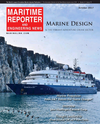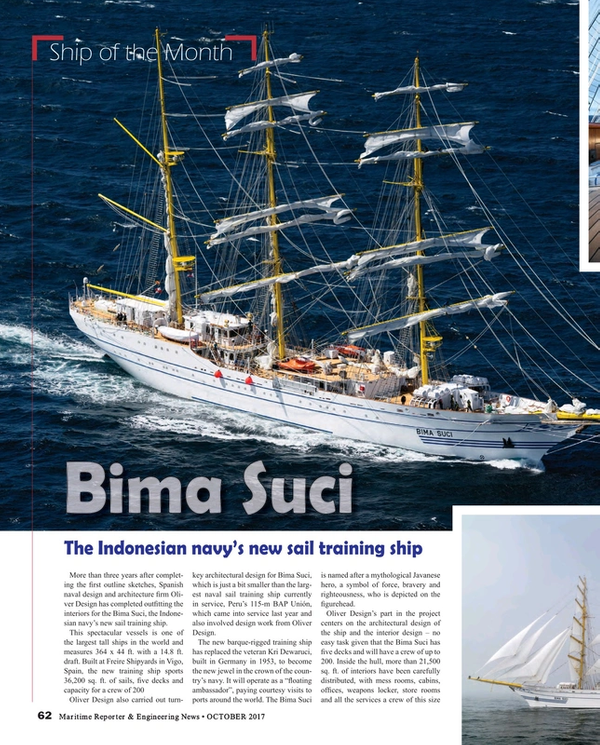
Ship of the Month: October 2017
Maritime Reporter & Engineering News
Bima Suci: The Indonesian navy’s new sail training ship
More than three years after completing the first outline sketches, Spanish naval design and architecture firm Oliver Design has completed outfitting the interiors for the Bima Suci, the Indonesian navy’s new sail training ship.
This spectacular vessels is one of the largest tall ships in the world and measures 364 x 44 ft. with a 14.8 ft. draft. Built at Freire Shipyards in Vigo, Spain, the new training ship sports 36,200 sq. ft. of sails, five decks and capacity for a crew of 200
Oliver Design also carried out turnkey architectural design for Bima Suci, which is just a bit smaller than the largest naval sail training ship currently in service, Peru’s 115-m BAP Unión, which came into service last year and also involved design work from Oliver Design.
The new barque-rigged training ship has replaced the veteran Kri Dewaruci, built in Germany in 1953, to become the new jewel in the crown of the country’s navy. It will operate as a “floating ambassador”, paying courtesy visits to ports around the world. The Bima Suci is named after a mythological Javanese hero, a symbol of force, bravery and righteousness, who is depicted on the figurehead.
Oliver Design’s part in the project centers on the architectural design of the ship and the interior design – no easy task given that the Bima Suci has five decks and will have a crew of up to 200. Inside the hull, more than 21,500 sq. ft. of interiors have been carefully distributed, with mess rooms, cabins, offices, weapons locker, store rooms and all the services a crew of this size requires (sick bay, barber shop, laundry, etc.). There will also be areas for training cadets and an imposing area designed for use as the captain’s cabin and for receiving visitors. There are two bridges on the main deck, one for steering the ship and a second for training cadets.
Requirements
As a military vessel, distribution on board is strictly hierarchical, with cadets, crew, instructors and officers all bunking in separate areas. The contract also required meeting strict regulations on thermal and acoustic insulation and fireproofing, as well as demanding conditions on durability and ease of maintenance of the materials used. As well as designing the interiors to these specifications, Oliver Design also took charge of building them, including the installation of insulation, primary deck covering, decorative flooring, bulkheads, ceilings, furniture and a vast range of decorative details. The interiors are of particularly high quality, and floors and furniture in the most representative areas are timbered in fine woods.
A team of 30 staff worked on the project over an 11-month period. The ship was launched in October last year, and was officially delivered to the Indonesian Navy on September 12, 2017.
Oliver Design, based in the Basque Country (Spain), has long experience in designing and fitting out classic sailing ships. Jaime Oliver, the firm’s founder and CEO, worked with the former Celaya shipyards on planning and construction of the training ships Guayas (Ecuador), Gloria (Colombia), Simón Bolívar (Venezuela) and Cuauhtémoc (Mexico), all built on Bilbao’s Nervion estuary in the 1970s and 1980s. Juan José Alonso was the last manager of the shipyard, which closed in 1988 and was in charge of contracting and construction for these four iconic vessels. He has been brought in as a consultant on the Bima Suci project.
In 2006, Oliver Design also participated in alteration and upgrade work to the Spanish navy’s Juan Sebastián Elcano and in design and outfitting of the Corwith Cramer, used to train students from the Sea Education Association, Boston University (USA). It was the first training vessel in the world to be certified by the U.S. Coast Guard and the last ship to be launched at the Celaya Shipyards in 1988. The contract for design and construction of the Bima Suci was signed in the Indonesian capital Jakarta in November 2012, following an international competition called by the country’s defense ministry, which attracted a dozen tenders. Freire shipyards’ successful tender was submitted with the collaboration of Oliver Design, who were responsible for the architectural design and interiors, and the German firm Detlev Loell & Partners, which supplied the rigging and sails. Construction of the vessel began in the shipyard in Vigo in October 2015.
The Indonesian Navy’s new cadet-training ship combines a classic design with the latest naval technologies. Its 1,300 kW main engine can reach speeds of 12 knots, with a maximum speed under sail of 15 knots. Like its predecessor, the ship will take part in international races and good-will missions.
A crew of 66 sailors, under the command of Captain Sutarmono, have been carrying out sailing exercises on board the Bima Suci before undertaking on September 18 the maiden voyage to its home port in Surabaya, on the north coast of the island of Java. The journey is expected to take around 60 days from the port at Vigo.
Watch the Sea Trials of Bima Suci here.
(as published in the October 2017 edition of Maritime Reporter & Engineering News)
Read Ship of the Month: October 2017 in Pdf, Flash or Html5 edition of October 2017 Maritime Reporter
Other stories from October 2017 issue
Content
- Supporting Silent Ships page: 14
- Cyber Shoal Waters page: 18
- US Shipbuilding: The Road Ahead page: 22
- Keller Shifts Gears page: 24
- MAN Introduces the 'Game Changer' page: 26
- Voices: Bjarne Foldager, MAN Diesel & Turbo page: 30
- Voices: John Haeflinger, Carnival Corp. page: 35
- Designer-built Adventure Cruise page: 40
- Robert Allan Ltd. Designs for the American Market page: 46
- Foreship: A Guiding Design Light amid a Quagmire of Regulations page: 50
- Hans Beele's Mission to Build Sealing Valley page: 58
- Ship of the Month: October 2017 page: 62


